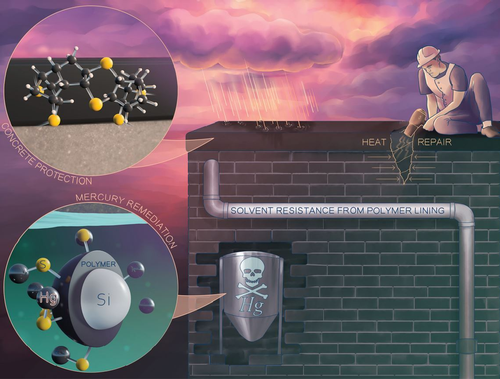TUESDAY, MARCH 22, 2022
Researchers from Flinders University in Australia recently developed a smart coating for pipelines that can remove mercury from water while preventing corrosion and solvent damage. The coating can also reportedly prevent acid and water damage of concrete surfaces.
The article, “Processes for coating surfaces with a copolymer made from sulfur and dicyclopentadiene,” was authored by Maximilian Mann, Dr. Bowen Zhang, Samuel J. Tonkin, Christopher T. Gibson, Zhongfan Jia, Dr. Tom Hasell and Justin M. Chalker and was recently published in the journal Polymer Chemistry.
About the Coating
“Made easily from elemental sulfur and dicyclopentadiene (DCPD is a by-product of petroleum refining), this new coating is multi-functional which gives us wide scope to use it in a wide range of useful ways and for longer lasting industrial products and components,” said Mann, a Flinders University PhD candidate and lead author. “This exciting new area of research extends fundamental chemistry to several practical applications.”
“The method for making the coating is safer than methods previously used for related coatings. The team developed a lower temperature process that prevented runaway reactions,” added co-author University of Liverpool researcher Dr. Zhang.

 |
| Flinders University |
|
Researchers from Flinders University in Australia recently developed a smart coating for pipelines that can remove mercury from water while preventing corrosion and solvent damage. |
According to the study, after a curing process at 140 C (284 F) and due to a reaction between the sulfur and DCPD, the material was rendered insoluble and resistant to acids and solvents. Researchers then coated silica gel with the soluble oligomer to test mercury removal from water.
100 milligrams of the coated silica were added to a solution of water and mercury, then agitated using an end-over-end mixer. This test was repeated, and the coating showed “highly effective” mercury absorption, with the uncured sample removing greater than 99% of mercury within two hours and the cured samples removing at least 92% of mercury in the same time.
To test the coating’s protection from corrosion and solvents, the team applied the coating technique to metal, concrete and polyvinyl chloride. Additionally, the use was extended to cement and tests showed protection from both acid and water penetration.
The research team reports that the coating is repairable from scratches and other damage with heat application. This process can take place due to the coating’s chemical structure, allowing sulfur-sulfur bonds to be broken and reformed.
“The unique chemical composition of the smart coating enables protection of substrates, active removal of toxic mercury species from water and oil, and is repairable which ensures its sustainability,” said Chalker, a professor from the Institute of Nanoscale Science and Technology at Flinders University.
“The coating is solvent resistant and can also remove mercury from oil and water mixtures, which is of importance to remediation in the petroleum and gas industry.”
The study was conducted in the United Kingdom in an exchange at Hasell's University of Liverpool lab as part of an ongoing collaboration between the Chalker Lab and Hasell Lab. The project was funded by the Australian Research Council.
Other Pipeline Coating Research
In 2018, researchers at Southwest Research Institute announced they developed a way to protect pipeline internals with a superhydrophobic coating that they believe will prevent the collection of hydrate crystals inside subsea pipelines.
SwRI’s Lotus family of coatings, so named for their superhydrophobic properties, can be applied in a specialized shop using a plasma deposition process.
“We produce these coatings using a vacuum process in which a plasma—a state of matter consisting of free electrons plus ionized atoms and molecules—is ignited inside the entire length of the pipe, while introducing one or more chemicals,” explained Michael Miller, a scientist at SwRI. “The process selectively fragments the chemicals into ions that are then accelerated onto the pipe surface where they immediately undergo polymerization to form a thin, glass-like, durable coating.”
The scientists who developed the line of coatings said they can be manipulated to exhibit different surface properties depending on the function they’re meant to serve.
Hydrates form in low-temperature pipelines when water combines with certain gases, forming icelike crystals that can remain solid above the freezing point of water. They pose a problem in pipeline internals when they form blockages, requiring expensive interventions to eliminate them. Hydrates are most likely to build up in high-pressure, low-temperature environments like subsea pipelines.
Hydrates are typically prevented via chemical additives or heating jackets, SwRI noted, which can prove costly. SwRI was working at the time with an energy services firm to commercialize the Lotus coating process for use in pipeline construction. SwRI said the Lotus coatings inside pipelines could also prevent the building up of paraffin and other substances that can build up inside deep petroleum wells.
Later that year, researchers based out of the University of Manchester and TWI Ltd. developed a way to incorporate graphene into a polymer liner that can extend the lifespan of marine pipelines.
The research, published in Advanced Materials Interfaces, indicates that if graphene were mixed with plastic, or if a single layer of graphene was applied, gases could still get through, which could damage the steel over time.
But when researchers laminated a thin layer of graphene nanoplatelets to polyamide 11—a plastic traditionally used in these pipeline liners—the team was able to create structures that acted as sound barriers. The material was tested at 60 degrees Celsius, at pressures up to 400 times higher than atmospheric pressure. The result? An over 90 percent reduction in CO2 permeation compared to PA11 alone. Hydrogen sulfide permeation was reduced to undetectable levels.
Graphene is flexible and transparent, with higher conductivity than copper, and is used to block helium, a gas known for being exceptionally difficult to block.
Tagged categories: Coating Materials; Coatings; Coatings technology; Colleges and Universities; concrete; Corrosion protection; Metal coatings; Pipeline; Pipelines; Polymers; Program/Project Management; PVC; Research; Research and development; Water/Wastewater